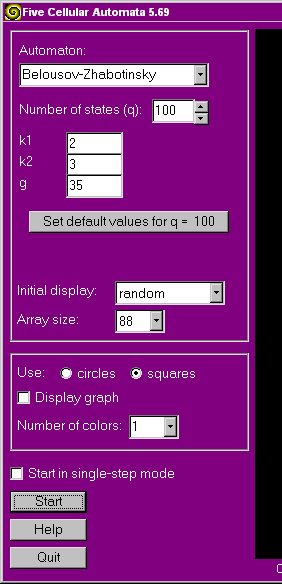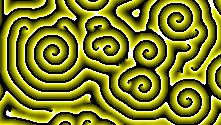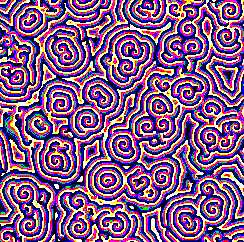 The Belousov-Zhabotinsky reaction is a spatio-temporal chemical oscillator. In 1951 the Russian scientist Boris P. Belousov discovered that if citric acid, acidified bromate and a ceric salt were mixed together the resulting solution oscillated periodically between yellow and clear. He had discovered a chemical oscillator. The scientific community was united in believing this to be impossible. Some years later
The Belousov-Zhabotinsky reaction is a spatio-temporal chemical oscillator. In 1951 the Russian scientist Boris P. Belousov discovered that if citric acid, acidified bromate and a ceric salt were mixed together the resulting solution oscillated periodically between yellow and clear. He had discovered a chemical oscillator. The scientific community was united in believing this to be impossible. Some years later
another Russian biophysicist, Anatol M. Zhabotinsky ... refined the reaction, replacing citric acid with malonic acid and discovering that when a thin, homogenous layer of the solution is left undisturbed, fascinating geometric patterns such as concentric circles and Archemedian spirals propagate across the medium. Therefore, the reaction oscillates both in space and time, a so-called spatio-temporal oscillator. — The Belousov-Zhabotinsky Reaction
 In the "Computer Recreations" section of the
August 1988 issue of Scientific American Professor A. K. Dewdney presented a cellular automaton whose behavior appears similar to the Belousov-Zhabotinsky reaction. Prof. Dewdney presented the automaton using the metaphor of infection passing from cell to cell. Cells could be in any of n+1 states, where a cell in state 0 was "healthy", a cell in state n was "ill" and a cell in any intermediate state was "infected". The rules to be applied to a cell, in order to determine its state in the next generation, are given on the Algorithms page.
In the "Computer Recreations" section of the
August 1988 issue of Scientific American Professor A. K. Dewdney presented a cellular automaton whose behavior appears similar to the Belousov-Zhabotinsky reaction. Prof. Dewdney presented the automaton using the metaphor of infection passing from cell to cell. Cells could be in any of n+1 states, where a cell in state 0 was "healthy", a cell in state n was "ill" and a cell in any intermediate state was "infected". The rules to be applied to a cell, in order to determine its state in the next generation, are given on the Algorithms page.
A slightly modified version of those rules is implemented in this Five Cellular Automata software. They are stated here.
The initial screen for the simulation of the Belousov-Zhabotinsky reaction has controls as shown at right:
Cells in state 1 are always displayed in black (or, one might say, are not displayed). Cells in state q are always displayed in white. Colors may be used for cells in states 2 through q-1. The number of colors used for these cells can be set to 1, 2, 4 or 8. When 2 colors are used then all cells are either black (state <= q/2) or white (state > q/2). When 1 color is selected then cells in states 2 through q-1 (when q >= 3) are displayed in one color of differing intensity (higher states are shown in brighter color). When 4 or 8 colors are used then colors are distributed equally among the states 2 through q-1.
As in the other two automata, the array size can be set from 33 to 528. The initial state can be set as described for q-state Life, and the graph similarly shows the progress of the average cell state.
The values of q, k1, k2 and g can be changed at will (subject to certain limits). Not all combinations of values produce interesting results. It seems that good spirals result only when k1 = 2 or 3 and k2 = 3. With these values spirals result only for a fairly narrow range of values for g. After setting q, clicking on the Set default values button will set k1 etc. to values which experiment has shown to produce spirals (provided k1 = 2 or 3 and k2 = 3).
 The state of the system shown in the image below was obtained from a random initial state (as at right). Spirals begin to emerge after a hundred or so steps.
The state of the system shown in the image below was obtained from a random initial state (as at right). Spirals begin to emerge after a hundred or so steps.
 The spirals slowly become larger as the run goes on. Using an array size of 528 (so that a cell is represented by one pixel instead of 2x2=4 pixels), and allowing the software to run for over a thousand steps, one obtains spirals such as those at right.
The spirals slowly become larger as the run goes on. Using an array size of 528 (so that a cell is represented by one pixel instead of 2x2=4 pixels), and allowing the software to run for over a thousand steps, one obtains spirals such as those at right.
 This cellular automaton provides an illustration of order emerging "spontaneously" from chaos. Starting from an array whose cells are in randomly assigned states, patterns eventually emerge. In other words, non-randomness emerges from randomness. This has significance for the question of whether complicated biological organisms can emerge from simpler ones as a result of chance occurrences (such as genetic mutations). Before drawing such a conclusion, however, we should note that in this cellular automaton pattern emerges from chaos only if the parameters governing the evolution of the system have values within a certain fairly narrow range. q = 200, k1 = 2, k2 = 3 and g = 70 produce spiral patterns, but spirals do not emerge for most other sets of values.
This cellular automaton provides an illustration of order emerging "spontaneously" from chaos. Starting from an array whose cells are in randomly assigned states, patterns eventually emerge. In other words, non-randomness emerges from randomness. This has significance for the question of whether complicated biological organisms can emerge from simpler ones as a result of chance occurrences (such as genetic mutations). Before drawing such a conclusion, however, we should note that in this cellular automaton pattern emerges from chaos only if the parameters governing the evolution of the system have values within a certain fairly narrow range. q = 200, k1 = 2, k2 = 3 and g = 70 produce spiral patterns, but spirals do not emerge for most other sets of values.
A plausible account can be given (see William F. Loomis, Four Billion Years: An Essay on the Evolution of Genes and Organisms) of how living systems might have developed on Earth four billion years ago (starting from only a primordial soup of fairly simple molecules). But this process could have occurred only if the laws of physics, chemistry and thermodynamics (and physical constants) are such as they are (and presumably were then). So the fundamental question is: Why are these laws as they are? No-one has a good answer to this question, in the sense of being able to provide reasons (other than that these laws had to be as they are in order for life to develop and thus so that this question could be asked). It may be that our universe is simply one of many possible universes (perhaps an unlimited number of them) which have come into existence at one "time" or another, each with slightly different laws and constants, almost all of those universes being barren, but that ours is one of the very rare ones in which the laws and constants are such that life can emerge. Contrary to Einstein's view, God may in fact play dice with the universe, or rather, in the game of all possible universes.
| Next: Togetherness | |
| Five Cellular Automata | |
| Hermetic Systems Home Page | |